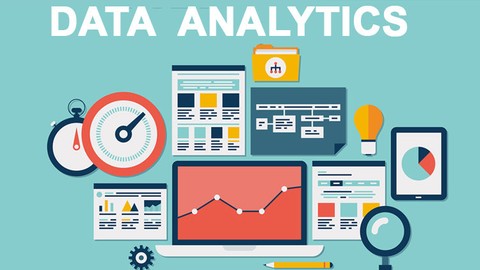
SAS Programming: Data Manipulation and Analysing Techniques
SAS Programming: Data Manipulation and Analysing Techniques, available at $49.99, has an average rating of 3.75, with 93 lectures, 7 quizzes, based on 43 reviews, and has 1536 subscribers.
You will learn about You can do data analysis easliy. You can transpose your data, add new calculated columns. You can delete some values in your data, and impute them also. After you finish this course, you can start applying data mining techniques and create data models. This course is ideal for individuals who are If you want to be a data engineer or data scientist, this course is really helpful. or If you want to learn data transformation, cleansing and analysing techniques, this course provides foundations. It is particularly useful for If you want to be a data engineer or data scientist, this course is really helpful. or If you want to learn data transformation, cleansing and analysing techniques, this course provides foundations.
Enroll now: SAS Programming: Data Manipulation and Analysing Techniques
Summary
Title: SAS Programming: Data Manipulation and Analysing Techniques
Price: $49.99
Average Rating: 3.75
Number of Lectures: 93
Number of Quizzes: 7
Number of Published Lectures: 93
Number of Published Quizzes: 7
Number of Curriculum Items: 100
Number of Published Curriculum Objects: 100
Original Price: $19.99
Quality Status: approved
Status: Live
What You Will Learn
- You can do data analysis easliy.
- You can transpose your data, add new calculated columns.
- You can delete some values in your data, and impute them also.
- After you finish this course, you can start applying data mining techniques and create data models.
Who Should Attend
- If you want to be a data engineer or data scientist, this course is really helpful.
- If you want to learn data transformation, cleansing and analysing techniques, this course provides foundations.
Target Audiences
- If you want to be a data engineer or data scientist, this course is really helpful.
- If you want to learn data transformation, cleansing and analysing techniques, this course provides foundations.
What are we going to learn in this course?
-
Firstly we are going to download and install SAS University Edition which is totaly free.
-
We will convert Excel tables to SAS tables.
-
We will write lots of SAS functions and create new variables/columns.
-
We will write SQL scriptsalso, and we will compare SAS and SQL codes.
-
We will joindifferent tables, and filter&sort tables.
-
We will create graphseasily.
Creating meaningful data is the first step for the all data processes. If you want to create a model, apply data mining model, you have to apply this step firstly.
If you want to become a data engineer or data scientist, this course is really helpful.
You can understand and analysis data with some basic and easy functions in SAS which will be explained in the lesson.
Then you can manipulate data, impute missing variables and create new columns, merge different tables with SAS.
At the end of the course, you can apply all techniques to create clean and meaningful data with SAS.
Lots of functions and examples are applied in this course, if you have any question about a function, I can answer you quickly and also you can suggest new topics or functions to me. Lots of additions will be done in this course.
Course Curriculum
Chapter 1: Introduction
Lecture 1: Course Content
Lecture 2: Introduction to SAS
Lecture 3: SAS Installation
Lecture 4: Introduction to SAS Panels
Lecture 5: First SAS Program
Chapter 2: SAS Variable Types
Lecture 1: SAS Variable Types
Lecture 2: Create Variable Types
Lecture 3: Set Statement
Lecture 4: Drop and Keep Variables
Chapter 3: Import and Export Tables in SAS
Lecture 1: Length Function
Lecture 2: Create Datalines
Lecture 3: Create New SAS Library
Lecture 4: Import Excel Tables into SAS
Lecture 5: Convert SAS Table to Excel Table
Lecture 6: Rename Statement
Lecture 7: Compress Function
Chapter 4: Filter and Sort SAS Tables
Lecture 1: Filter Table with Where Statement
Lecture 2: Sort SAS Table
Lecture 3: Limit Data Observation
Chapter 5: SAS Functions
Lecture 1: Min and Max Functions
Lecture 2: Sum Function
Lecture 3: Divide Function
Lecture 4: Round Function
Lecture 5: Range Function
Lecture 6: Stdev Function
Lecture 7: Log Function
Lecture 8: Special _N_ Character
Lecture 9: Date Functions
Lecture 10: Date Calculation Functions
Lecture 11: Uppercase and Lowercase Functions
Lecture 12: Length and Count Functions
Lecture 13: Substring Function
Lecture 14: Tranword Function
Lecture 15: Compress Function
Lecture 16: Any Functions
Lecture 17: Find Function
Lecture 18: Cat Functions
Lecture 19: Convert Character to Numeric
Lecture 20: Convert Numeric to Character
Lecture 21: Convert Character to Date
Chapter 6: If-Else Conditions
Lecture 1: If Else Condition : Part1
Lecture 2: If Else Condition : Part2
Lecture 3: If Else Condition: Part3
Lecture 4: If Else Condition : Part4
Chapter 7: SAS Procedures
Lecture 1: Introduction to SAS Procedures
Lecture 2: Procedure Means
Lecture 3: Procedure Correlation
Lecture 4: Procedure Summary
Lecture 5: Procedure Append
Lecture 6: Procedure Transpose
Chapter 8: Join / Merge SAS Tables
Lecture 1: Introduction to Join Types
Lecture 2: Inner Join
Lecture 3: Full Outer Join
Lecture 4: Left and Right Joins
Chapter 9: Using SQL in SAS
Lecture 1: Introduction to SQL
Lecture 2: First SQL Code in SAS
Lecture 3: SQL Rename Statement
Lecture 4: SQL Keep Columns
Lecture 5: SQL Create Columns
Lecture 6: SQL Select Distinct Columns
Lecture 7: SQL Filtering Data
Lecture 8: SQL Sorting Data
Lecture 9: SQL Filtering and Sorting Data
Lecture 10: SQL Length Function
Lecture 11: SQL Numeric Functions
Lecture 12: SQL Character Functions
Lecture 13: SQL Case-When Condition
Lecture 14: SQL Join Types
Lecture 15: SQL Inner Join
Lecture 16: SQL Full Outer Join
Lecture 17: SQL Left Join
Lecture 18: SQL Right Join
Lecture 19: SQL Join and Filter&Sort
Chapter 10: Creating Charts and Plots
Lecture 1: Bar Chart
Lecture 2: Box Plot
Lecture 3: Distribution Graph
Lecture 4: Line Plot
Lecture 5: Scatter Plot
Lecture 6: Pie Plot
Chapter 11: Statistical Analysis with Tools
Lecture 1: One Way Frequencies Task
Lecture 2: Summary Statistics Table
Lecture 3: Table Analysis
Instructors
-
Büşra Fenerci
Computer Engineer
Rating Distribution
- 1 stars: 2 votes
- 2 stars: 4 votes
- 3 stars: 6 votes
- 4 stars: 14 votes
- 5 stars: 17 votes
Frequently Asked Questions
How long do I have access to the course materials?
You can view and review the lecture materials indefinitely, like an on-demand channel.
Can I take my courses with me wherever I go?
Definitely! If you have an internet connection, courses on Udemy are available on any device at any time. If you don’t have an internet connection, some instructors also let their students download course lectures. That’s up to the instructor though, so make sure you get on their good side!
You may also like
- Best Cybersecurity Fundamentals Courses to Learn in December 2024
- Best Smart Home Technology Courses to Learn in December 2024
- Best Holistic Health Courses to Learn in December 2024
- Best Interior Design Courses to Learn in December 2024
- Best Nutrition And Diet Planning Courses to Learn in December 2024
- Best Yoga Instruction Courses to Learn in December 2024
- Best Stress Management Courses to Learn in December 2024
- Best Mindfulness Meditation Courses to Learn in December 2024
- Best Life Coaching Courses to Learn in December 2024
- Best Career Development Courses to Learn in December 2024
- Best Relationship Building Courses to Learn in December 2024
- Best Parenting Skills Courses to Learn in December 2024
- Best Home Improvement Courses to Learn in December 2024
- Best Gardening Courses to Learn in December 2024
- Best Sewing And Knitting Courses to Learn in December 2024
- Best Writing Courses Courses to Learn in December 2024
- Best Storytelling Courses to Learn in December 2024
- Best Creativity Workshops Courses to Learn in December 2024
- Best Resilience Training Courses to Learn in December 2024
- Best Emotional Intelligence Courses to Learn in December 2024





















